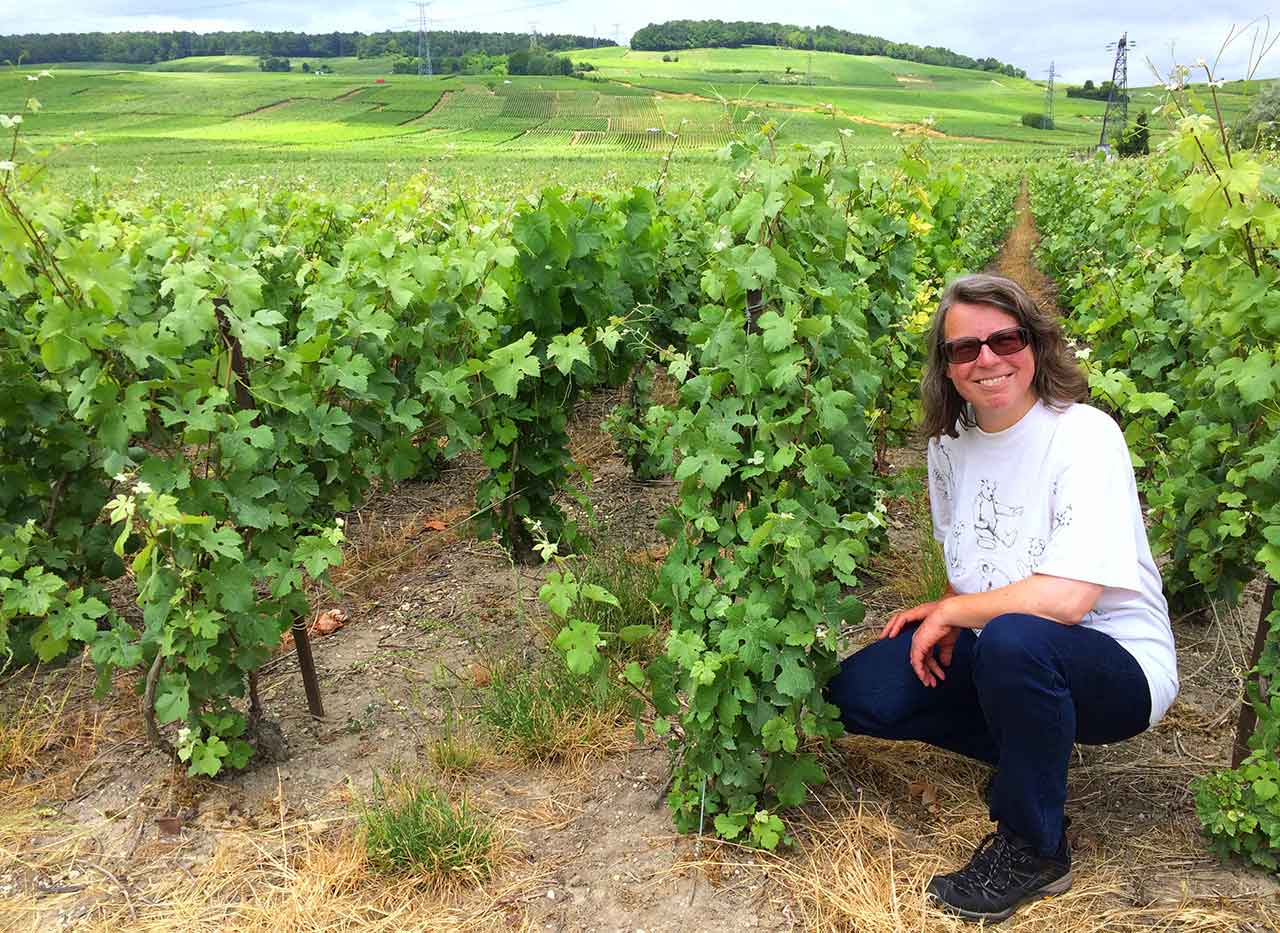Sack
An old English term for a white, fortified wine from Spain or the Canary Islands, which we would now call sherry.
Saignee
From the French for "bleed", this is a rosé wine made by draining - or bleeding - off some juice from a red wine fermentation. The removed juice makes a rosé with quite a strong colour and character. The wine left behind has a greater proportion of grape skins so it becomes richer and redder.
Salmanazar
A large wine bottle with a capacity of 9 litres, the equivalent of 12 normal wine bottles.
Sancerre
A French wine AOC area in the eastern Loire Valley, commonly associated with the growth of sauvignon blanc grapes.
Sangiovese
A red wine grape from central and southern Italy. The name derives from the latin sanguis Jovis meaning "the blood of Jupiter".
Sangria
A Spanish punch based on red wine, often Rioja. Recipes vary but often include slices of orange, lemon or apple, berries, and sweetened with sugar or orange juice.
Sassicaia
An Italian Super Tuscan wine made from cabernet sauvignon grapes and intended to ape the style of Bordeaux.
Sauternes
A sweet, white French wine from the Sauternais region, made from grapes which have had their flavour concentrated by Botrytis.
Sauvignon Blanc
A white wine grape originating in France but now grown all over the world. Sauvignon blanc wines from colder climates tend to be acidic, with green flavours of citrus and gooseberry, while warmer climate wines develop sweeter melon and peach notes.
Schilfwein
A German term for a straw wein, where the grapes are dried out before fermenting to concentrate the juice. Traditionally the grapes are dried on straw mats.
Schloss
German for castle. In wine terms, the equivalent of the French chateau.
Screw cap
Method of sealing a wine bottle using a thin aluminium lid with an internal plastic seal, which simply unscrews. The easiest and quickest way into a bottle of wine, which secures it the WineUncorked preference. Screw caps are reliable when new but can fail after many years of storage.
Seamless
Description of a wine where the flavours develop evenly and progressively from the initial taste to the finish.
Sec, Secco, Seco
Terms denoting dry wines - French, Italian and Portuguese respectively.
Second pressing
Pressing the grape pomace a second time to extract more juice. Wine made from this second pressing have more flavour and more colour and can be blended with the main batch to adjust is characteristics.
Secondary aromas
Characteristics developed in the wine due to the winemaking technique, for example maturing in oak barrels. Compare primary aromas and tertiary aromas.
Secondary fermentation
Another name for malolactic fermentation, a process which softens red wines.
Second wine
A winemaker's lower-quality product.
Sediment
Solids which settle out of a wine during production, or once it has been bottled. Often wines which are intended to age in the bottle for some time will show some sediment: this is not a fault. To avoid getting the sediment in your last glass, ensure the wine is not shaken about too much when opening - leave it to settle again if necessary. Pour the last of the wine slowly and watch for the sediment appearing at the neck of the bottle. With some care it is possible to catch the sediment in the shoulder of the bottle, before it drops into the glass.
Sekt
A German sparkling wine.
Selection
Selection wines are the finest German wines of a vintage.
Selection de grains nobles (SGN)
French term indicating that a wine is made from a "selection of noble berries", meaning grapes affected by noble rot (Botrytis). The first of these wines was made in Alsace.
Semi-generic
Wines made in the US and named after geographical areas outside America, such as California champagne. Other permitted names are: burgundy, claret, chablis, chianti, malaga, marsala, madeira, moselle, port, retsina, rhine wine or hock, sauterne, haut sauterne, sherry, or tokay.
Sémillon
A yellow Bordeaux grape used to make dry and sweet white wines.
Semisecco, semi-seco
Italian and Spanish terms for medium-dry white wine.
Semi-sparkling
Wines with a gentle fizz, but less than a 'full' sparkling wine. Think Lambrusco rather than Champagne.
SGN
Short for Selection de Grains Nobles.
Sherry
A fortified Spanish wine from the region around Jerez in Andalucia. After fermentation the base wine has a grape-based spirit added to increase the proportion of alcohol.
Shiraz
The New World term for the Syrah grape.
Short
A wine where the finish is not long-lasting in the mouth. Compare long.
Shoulder
The curved upper section of a bottle just below the neck, more commonly found on red wine bottles. With skilful pouring the shoulder can be used to separate sediment from the last of the wine.
Silex
A grape-growing soil consisting of flint, rock and sand.
Silky
Said of wines that feel smooth and velvety in the mouth.
Simple
Said of wines that are not complex in character. Simple wines have one, or few, flavours and are often uninteresting.
Single blind
A single blind tasting is where the tasters know the range of wines being assessed, but do not know in which order they are presented.
Single vineyard
Wines produced from the grapes of one vineyard, rather than from grapes sourced from many vineyards.
Skin
The outer part of the grape. The colour of red wine comes from the grape skins which are left in contact with the fermenting juice.
Slate
Grape-growing soil which is acidic and rich in minerals.
Slow oxidation
Removing the cork or screw cap from a bottle of wine and allowing it to stand for a long period before drinking. The theory is that this aerates the wine and allows it to develop its full flavours, in the same manner as decanting. However studies have shown it does very little to influence the flavour of the wine, because the surface area of wine exposed to oxygen is so small.
Slurp
The noise a wine taster makes by drawing air through a mouthful of wine. It's not done just to show off: mixing air into the wine as it is tasted helps to release its flavours. Also used light-heartedly to refer to a glass of wine: "a quick slurp".
Smaragd
Austrian wines from the Wachau region made from the ripest grapes and with at least 12.5% alcohol by volume.
Smoky
Wines that exhibit flavours of fire and burning are often decribed as 'smoky'.
Smooth
A combination of soft mouthfeel and seamless structure. Smooth wines have no abrupt changes of flavour.
Soft
A round and fruity wine without aggressive flavours or overpowering tannins.
Solera
A blending system used in the production of Sherry, where newer batches are used to top up older wines as they mature.
Solomon
A large wine bottle with a capacity of 20 litres, equivalent to 26.6 normal wine bottles.
Sorting
Picking over the grapes to remove unripe or damaged fruit, or foreign bodies, before fermentation. Sorting can be done by hand or machine.
Sommelier
An expert wine waiter.
Sommelier knife
Corkscrew incorporating a small folding knife for cutting the capsule. Also known as a waiter's friend.
Sound
Said of a wine that has no significant faults. Often a euphemism for "not very interesting".
Soutirage
The French word for racking, the process of removing the fermented juice from the dead yeast and detritus.
Sovereign
A large wine bottle with a capacity of 25 litres, equivalent to 33.3 normal bottles.
Sparkling
A wine with an effervescence or fizz, such as champagne and cava, caused by dissolved carbon dioxide.
Spätlese
The lightest of the 'late harvest' wines made from fully ripe grapes in Germany and Austria.
Spicy
Said of a wine that has flavours of black pepper, cumin, coriander, paprika or other spices.
Split
A small wine bottle with a capacity around a quarter of a normal wine bottle.
Spoofilated
Wines made using a variety of modern techniques and corrections, which are unknown and sometimes outlawed in the Old World.
Spritz
Sparkle, in general. Also an Italian cocktail based on red or white wine with water added.
Spritzer
A long drink made from white wine and sparkling water.
Spritzig
A German term for a lightly sparking wine,
Spumante
An Italian term for a sparking wine.
Spur pruning
Type of pruning used on cordon-trained vines, where long lateral growths are supported on a trellis system. New growth is trimmed back in winter to short offshoots or spurs.
Steely
Said of wines with a sharp, acidic flavour. Unlikely to have been aged in wooden barrels.
Steen
White grape variety grown in South Africa.
Steinfeder
Lightest of the three wine classes in the Austrian Wachau region, denoting wines with 11.5% alcohol or less.
Stelvin
A well-known brand of screw cap. The name has become a generic for screw cap, the way the British say hoover when the mean vacuum cleaner, and Americans say Kleenex instead of tissues.
Stemmy
Said of a wine with green or woody flavours, which can be introduced by the fermenting juice being left in contact with grape stems and skins for too long.
Stemware
Stemware is the class glass vessels with stems, such as (most) wine glasses. The stem of a wine glass can be used to hold the glass to avoid over-warming the contents of the glass.
Stickies
Australian term for sweet dessert wines.
Stravecchio
Italian for "very old". Often used to describe old marsala.
Strohwein
A German term for a straw wein, where the grapes are dried out before fermenting to concentrate the juice. Traditionally the grapes are dried on straw mats.
Structure
A tasting term referring to the main building blocks of the wine's flavour, and their relationship with each other. Tannins and acidity are the key factors, and most tasters also consider the wine's fruit, sweetness and body to be elements of its structure. A wine that is badly structured may be missing one of these elements, or has one which dominates to the exclusion of the others.
Sulphites/sulfites
Chemical compounds such as sulphur dioxide (SO2) which are added to wine to reduce oxidation and protect against bacteria growth. Small amounts are created naturally during the fermentation process. A small number of people (often asthma sufferers) are sensitive to sulphites but the belief that sulphites cause headaches has no basis in science. Even wines that do contain sulphites have low levels: processed meat and dried fruit can contain far more.
Sulphur/sulfur
Usually used in connection with the sulphur-based compounds sulphites/sulfites - see above. A "sulphurous" note in wine tasting indicates a "rotten eggs" smell, though strictly speaking sulphur itself has no flavour and that unpleasant odour is due to sulphur dioxide.
Sulphur/sulfur dioxide (SO2)
A preservative and anti-oxidant, sometimes seen on food labels as E220. It is commonly added to wine, and also occurs naturally. See sulphites/sulfites above.
Super Seconds
Bordeaux wine estates which are not in the highest quality "First Growth" class, but which approach them for quality.
Super Tuscan
Italian wines from Tuscany which are high quality and command high prices, but because they are made outside the established DOC regions they only carry the lowly "vino da tavola" (table wine) designation.
Supérieur, Superiore
French and Italian words for "superior", usually indicating a wine with a higher alcohol content. Sometimes the wine is from older, theoretically higher quality vines, and may have received more aging before release.
Supple
Wines that feel rich and soft in the mouth, without dominant tannins.
Sur lie
Dead yeast separates out from the wine during fermentation, known as the "lees" or in French the "lie". Often these solids are removed before the wine is left to age, but a wine which is matured "sur lie" is left in contact with this material during the maturation. The result is a wine which is richer and more complex in character.
Sur pointe
Maturing a sparkling wine in the bottle with the neck downwards, so that dead yeast collects in the neck.
Stainless steel
Material for wine-making vats which became popular in the 1980s. Stainless steel vats allow finer control over winemaking conditions and are more neutral, so the resulting wine is more a reflection of the winemaker's technique.
Süss, Süssreserve
German term for unfermented grape juice which is added to wine to sweeten it prior to bottling.
Synthetic cork
A plastic stopper designed to resemble a natural cork, and to be extracted in the same way using a cork screw. Synthetic corks can often be tight in the neck of the bottle and can slide off the corkscrew, making them harder to remove. Being a more inert and consistent material they avoid cork taint and make the aging of the wine less variable. But purists still prefer natural corks.
Syrah
French red-wine grape variety. In the New World the same grape is known as shiraz. Syrah wines are commonly medium or full-bodied and commonly have black pepper notes.
Szamorodni
A Hungarian wine style made from a mixture of normal and Botrytis-affected grapes.
Száraz
Hungarian for dry wine.






